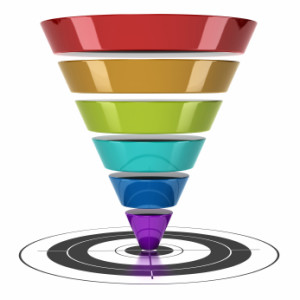by gabriel_sales | Jul 3, 2014
 Last week, we wrote about the state of the marketing automation industry in 2014 and offered some questions for people to ask when considering purchasing a marketing automation software.
Last week, we wrote about the state of the marketing automation industry in 2014 and offered some questions for people to ask when considering purchasing a marketing automation software.
This week, we’ll take a look at a new study from Bizo and Oracle that looks at the value of marketing automation across various tactics in the sales cycle.
The most significant finding from the report was about marketing’s contribution to overall company revenue. The report found that for companies currently using marketing automation software, marketing contributes 20-60% of overall revenue.
This finding suggests that the days of ‘impressions’ and ‘branding’ as measures of marketing effectiveness are over. Using technology, marketing’s contribution can now be tied directly to hard numbers, which means that marketers can now be held more accountable than ever before.
Another key finding from the report has to do with lead nurturing. The report found that 94% of respondents use lead nurturing (taking into account that the respondents from this study were Bizo’s marketing database, “which naturally will over-represent companies currently using marketing technology”). 35% of those engaged in lead nurturing find the practice very important (“we couldn’t live without it”) and 58% find it somewhat important (“we have a few nurturing campaigns running”).
With the rise of lead nurturing and its perceived effectiveness, it would make sense that marketers are looking for ways to improve the effectiveness of their nurturing campaigns. The study from Bizo suggests that one way companies are doing this is by taking a multi-channel approach. CMO of Bizo, David Karel, commented:
“Relying solely on email for lead nurturing is preventing B2B marketers from getting to the next level of business impact. With only five percent of website visitors willingly providing an email address, marketers’ need to find other channels or risk limiting nurturing efforts to a very small portion of their target audience. Multi-channel nurturing represents a massive opportunity to reach prospects beyond the inbox and really boost the return on their marketing spend.”
Read the entire report from Bizo here.
For more on using marketing automation for B2B sales and marketing, you can read 3 Tips for Leveraging B2B Marketing Automation in 2014.
by gabriel_sales | Jul 3, 2014
 The B2B sales and marketing world today is a digital one. In the past decade, nearly all non-digital sales tactics and techniques have greatly declined in effectiveness while their digital replacements have experienced a nearly exponential rise in popularity.
The B2B sales and marketing world today is a digital one. In the past decade, nearly all non-digital sales tactics and techniques have greatly declined in effectiveness while their digital replacements have experienced a nearly exponential rise in popularity.
All of this obviously changed the B2B sales and marketing landscape dramatically. No longer concentrated on tradeshows and industry-related print publications, successful B2B companies today are focused on integrating digital technologies into their sales process for better targeting and increased efficiency.
And while this digital integration and technological expertise is now a requirement for successful B2B sales and marketing, the question remains: is there any merit to keeping some of those older tactics in your toolbox?
Teleservices
When it comes to B2B teleservices, our opinion is yes. While digital tactics and technologies can greatly improve many aspects of your sales process, there are some things that will never be able to be automated and will always require a more traditional, people-oriented approach.
For example, it is fairly easy to generate a lead via inbound digital marketing techniques: someone goes to a search engine, types in a keyword and ends up on your site exploring your content. If you have a marketing automation software that ‘cookies’ your prospects and tracks their content engagement, it is easy to see when a prospect is showing some type of interest.
However, using marketing automation and other web tools, it is not always as easy to figure out just how interested your prospect is and what their real intentions are. Just by watching clicks and page views, you cannot tell if a prospect is desperate to find a solution this week or if it is a competitor trying to ‘borrow’ content ideas.
This is where teleservices can work wonders. When inbound leads come in and show a fair amount of engagement with your marketing content, that is when to have your sales reps call to do some qualifying. As we’ve written about previously, having a sales rep call after a prospect has already shown interest by engaging digitally greatly decreases the ‘coldness’ of the call. The prospect is already somewhat familiar with the company and is generally engaged enough to be open to a discussion at this point.
Read more on this topic here. Feel free to contact us with any questions.
by gabriel_sales | Jun 27, 2014
 By now, everyone in B2B knows that quality marketing content can contribute directly to sales. The idea is that by giving your prospects valuable content that assists them in their buying process, you help build the trust required to motivate a purchase.
By now, everyone in B2B knows that quality marketing content can contribute directly to sales. The idea is that by giving your prospects valuable content that assists them in their buying process, you help build the trust required to motivate a purchase.
In attempting to use marketing content for sales objectives, one mistake a lot of companies make is failing to help prospects move smoothly through each stage of their buying process. Many companies simply make a bunch of content, throw it up on their website and expect magic to happen. There’s a little more to it than that.
The content you create, whatever it says, needs to help guide prospects—stage by stage—through your sales cycle. This means you need to different create content for each stage (discovery, education, verification, etc.) that speaks directly to the main interests and concerns prospects have while in each stage.
For example, let’s say you are selling marketing automation software. Some of your early-stage prospects are going to have no idea what marketing automation is. For these prospects, you need to have some light, educational content that answers the basic question, “What is Marketing Automation?” However, other prospects are already going to know a lot about marketing automation and want content that helps them to compare options and verify they’re making the right choice. For these prospects, different content—e.g. a software comparison matrix—is needed to assuage concerns and keep the deal moving forward.
Once you have content created for each stage of your buyer’s journey, you are almost set up for success, but not quite. The final step is connecting the dots for your prospects, so they can take themselves through your sales process on their own. This is relatively easy to do, but requires some thought.
Connecting the dots for your prospects requires getting into their head and figuring out how a prospect is likely to think through your buying process. Using the example above, an early stage marketing automation shopper will first wonder, “What is marketing automation?” then, they might ask, “What advantages will marketing automation give me?”. If the prospect is still interested at this point, they might ask, “Is my company ready for this type of investment?” Once a prospect has decided they want to make a purchase, their questions might change to things like, “What is the implementation process like?” or “What payment options do I have?”
As you can see, each of these questions requires a different piece of marketing content. However, you can make the process of going through all the content smoother by leaving different links or ‘breadcrumbs’ that guide prospects logically through each stage. Using our marketing automation example, at the end of the “What is marketing automation?” content, add a link to a blog on “5 Advantages of Marketing Automation in 2014”. At the end of the ‘advantages’ blog, leave a link to a video on “How to know if your company is ready for marketing automation”. And on and on to the end of your sales cycle.
Many times, prospects only need a little bit of help to get them to take an action to take the deal forward. By making it as easy as possible for prospects to self-educate and take themselves through their own buying process, we make it more likely that prospects will like us and eventually, trust us enough to make a purchase.
Read more about creating content for sales in 5 Steps to B2B Content Engagement Success.
by gabriel_sales | Jun 19, 2014
B2b content engagement (continued) 
This is the second part of a 2 part blog on B2B content engagement. You can find part 1 here.
3. Make your prospect the hero
If the story you are telling in your marketing content features you as the main protagonist, you’re doing yourself a disservice. Building on the point above, stories enable people to imagine themselves in other scenarios and internalize new ideas or beliefs as their own.
By creating a story that allows your prospect to imagine himself as a hero (e.g. saving the day and earning the boss’s praise for finding the perfect solution for X), you create a major incentive to transact, so he can become that hero he imagined.
- Set up an emotional experience
We’ve written previously on why emotional connection matters more in B2B than in does in B2C. One aspect is that with higher risk sales, people need emotional assurance that things will go well in order to ease their anxieties.
Additionally, “behavioral psychologists have long argued that only 30% of human decisions are actually driven by rational considerations. This means more than 70% of customer loyalty and spending decisions are based on emotional factors.” Because we are so emotionally motivated, anything you can do to create an emotional experience for your readers will keep them more engaged. There are many ways you can facilitate an emotional response in your marketing content—humor, building action to create excitement, ending with a ‘hook’ to keep people coming back for more, etc.
5. Get it out there. Fast.
One of the biggest mistakes B2b companies make in their initial content marketing efforts is thinking that all you have to do to get prospects to engage with you is post content on their website. In terms on engagement, publishing content—like a blog—should merely be the first step in getting the content to your target audience.
Additionally, founder of Moz Rand Fishkin recently wrote that in terms of SEO, “One of the harsh truths of blog-focused SEO is that a few hours after a post is published, 90% of the ranking ability is spent. . . It’s that first burst of activity – of social sharing and people emailing it around and links coming in – that set the stage for ranking success in the search engines.” This means that the quicker you can get your content out and shared on a variety of platforms, the wider the reach your content will have and consequently, the more engagement.
For more tips on creating engaging marketing content, you can read 5 Ways Your B2B Content Marketing Program Can Fail. Feel free to contact us with any questions.
by gabriel_sales | Jun 16, 2014
 B2B companies today know they need content. This is very clear by the fact that thousands of B2B blogs and videos are now posted every week. But how do you get it to actually do the things you want it to (e.g. generate leads, increase brand awareness, motivate a transaction, etc.)?
B2B companies today know they need content. This is very clear by the fact that thousands of B2B blogs and videos are now posted every week. But how do you get it to actually do the things you want it to (e.g. generate leads, increase brand awareness, motivate a transaction, etc.)?
Here are 5 steps to B2B content engagement success:
1. Start with your audience
If you start by asking yourself, “What kind of content do I want to make today?” you’re doing it wrong. The first question should be, “What type of content does my specific audience want to engage in?”
For example, do your prospects like quick and fun blog posts or in-depth, technical white papers? If you don’t know the answer to that question, it is pretty easy to do some research, and find out what your competitors are doing. You can also directly ask your prospects what type of content would be helpful to them, which can help you to prove your value during the sales process.
2. Tell a story
Incorporating storytelling into your B2B marketing content seems to be one of the big marketing trends of 2014, and for good reason. Adding storytelling elements to your content helps improve engagement by making your content easier to read and increasing the probability that prospects will retain your message.
By using a ‘beginning, middle, end’ structure, prospects can more easily follow the flow of your content as you present your argument, statistics or other information. Messages with stories also are remembered much better over time and “according to Uri Hasson from Princeton, a story is the only way to activate parts in the brain so that a listener turns the story into their own idea and experience.”
Continue reading.
by gabriel_sales | Jun 13, 2014
Looking to launch B2B sales marketing? Here are your options…
Most companies today have realized that the b2b sales marketing strategies and tactics that worked 10—or even 5—years ago do not work anymore. Marketing no longer revolves around positioning and impressions, and sales is more than endless cold calls and aggressive sales pitches.
B2B sales and marketing today is about having the ability to integrate your sales and marketing processes with digital tools and technologies to simultaneously improve effectiveness and increase efficiency. For B2B companies who have not yet gone through this integration, the process can be overwhelming and time consuming. For many companies, it can take over a year to implement and see results from a marketing automation platform.
In order to streamline these processes and handle the added complexity that comes with B2B sales today, many companies are currently looking to external resources. Companies have several options when it comes to outside sales and marketing resources, and the rest of this blog will look at the pros and cons of using freelancers for B2B sales marketing.
When Freelancers Work
- You have a specific, one-time project or issue.
- Hiring a freelancer can work when you have something that needs to be done that has a clear beginning and end (e.g. a website redesign or marketing brochure).
- You have a clearly defined gap that needs to be filled.
- A freelancer can be a fit when all of the other puzzle places are already in place. For example, you may have all the marketing technology you need running smoothly, but cannot keep up with the constant demands for content.
- You have project management processes and quality assurance standards in place internally.
- Because freelancers, by definition, are not your internal employees, they do not know how you work and what your standards for quality are. In order to get quality work on time, you need to have clearly defined processes and standards in place for freelancers to adhere to.
When Freelancers Don’t Work
- You are starting from scratch
- If you have yet to enter the world of content marketing, social media, customer relationship management and marketing automation, hiring a single freelancer is not going to get you where you need to be.
- The issues you are trying to solve involve different skill sets
- If the help you need involves both content creation and technology integration, you need an outsourced sales and marketing team, not a freelancer. Freelancers typically have very specialized expertise and cannot wear all the hats needed to set up and run a fully integrated sales and marketing program.
- You need help with strategy in addition to execution
- If you have a strategy and plan in place, it is relatively easy to plug freelancers into it. If you have yet to create a sales and marketing strategy, it is likely you need a more comprehensive solution before you will be able to execute successfully.
To learn more about the option of outsourcing your B2B sales marketing, read 5 Ways an Outsourced Sales Team Can Help Your Marketing Team. Feel free to contact us with any questions.
 Last week, we wrote about the state of the marketing automation industry in 2014 and offered some questions for people to ask when considering purchasing a marketing automation software.
Last week, we wrote about the state of the marketing automation industry in 2014 and offered some questions for people to ask when considering purchasing a marketing automation software.





